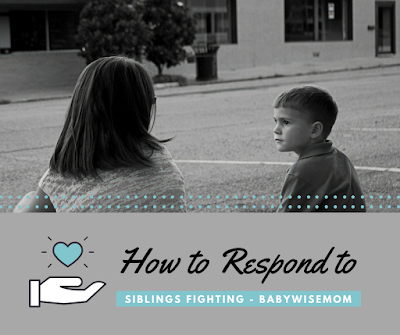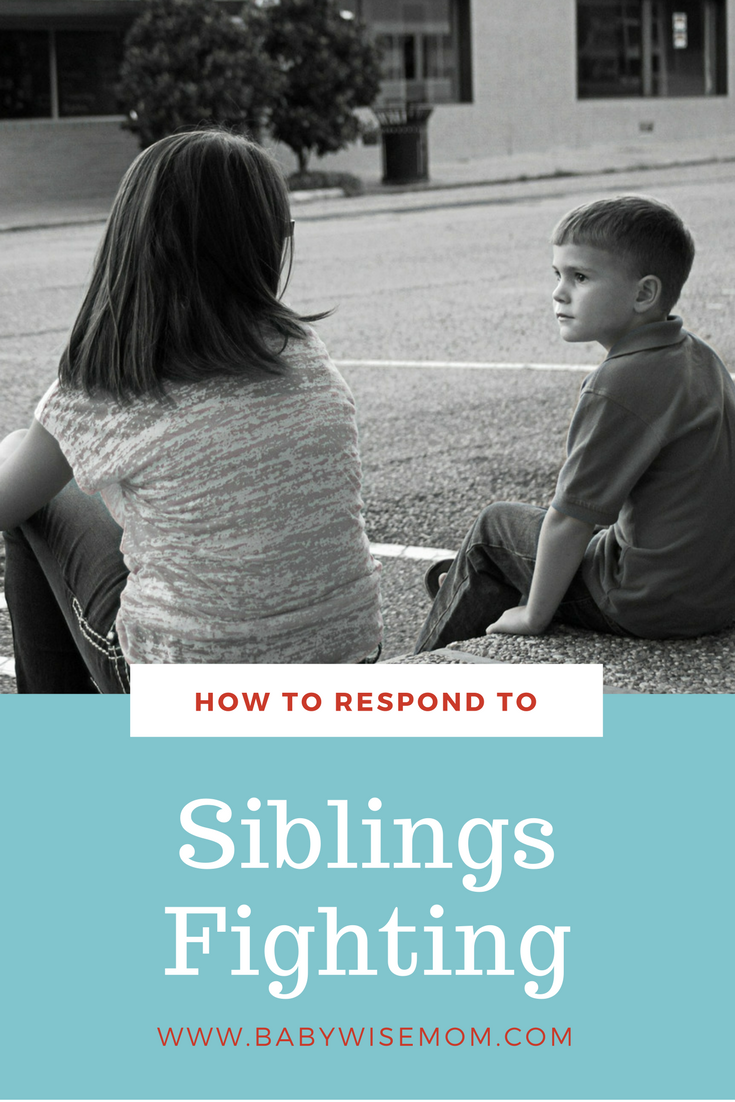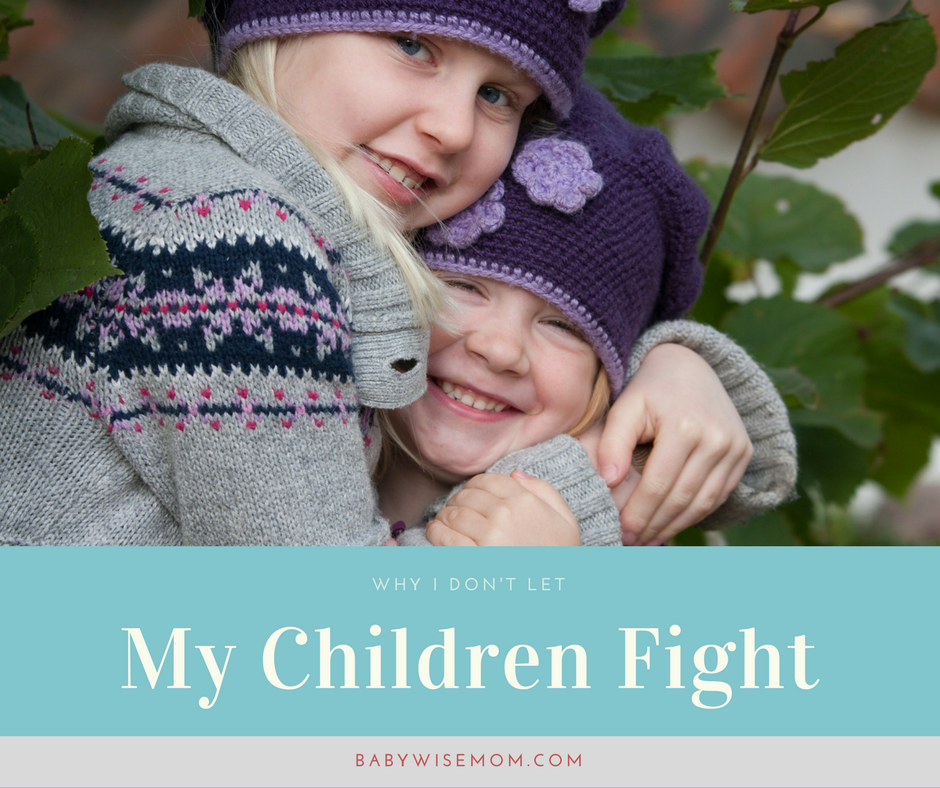When your children fight, you might not know how to best respond. You don’t want to create bitterness among the siblings. You also want them to learn to solve problems without your intervention. This post outlines tips on how to respond when you children fight.

The best of times and the worst of times. Sibling relationships are like that. Lots of good. Plenty of bad. The good warms your heart and the bad warms your blood pressure.
The question parents encounter is “What do I do when my kids fight?” Do you intervene or do you let the children settle it themselves? Do you ignore it? How do you respond to tattling? None of these questions have simple, quick black and white answers, but I hope to give you a guide in how to handle quarrels among siblings. This advice is based on how we respond to fighting at our house.
As a bit of anecdotal credibility, I have four children, ages 4-11 (almost 12). We have some fighting, but not much. For the most part, the children get along. One summer at an extended family camping trip, a few days into it my children “finally” had an argument. My cousin was thrilled to see they actually fought sometimes! They do fight at times, but it isn’t even a once-a-day thing here. What we do works well for our family.
Post Contents
1-Prevention is First
I am a huge proponent of the idea of “prevention” for any problem you are facing (or concerned about facing someday). The first step to managing fights among your children is to prevent them. Sounds nice, right?
One way to do prevent fights is to teach your child to love others (see my post Moral Training: Love). While children are naturally loving creatures, they are also naturally selfish (aren’t we all!). Teaching your child how to think of others and ways to show love toward others is a very helpful and positive step in helping your child get along with siblings. Along the same lines of loving, foster a friendship between your children. Your children will be more motivated to work toward getting along if they are friends and not just siblings.
You can prevent by teaching your child how to prevent conflicts from happening–or rather conflict resolution in early stages of conflict. When your children disagree, talk about what happened and what could have been done to prevent the fight from happening in the first place. What things should have been done differently? What things should have been said and not said? How could they have been less selfish? Children need to be taught these things.
You can also prevent by making sure your children are well-rested, well fed, and have a good routine going in life. This is setting your child up for success in playing with siblings. Children are more likely to fight when bored, tired, and hungry.
2-Establish Rules
This is along the lines of prevention. Establish rules for playing together. Again, children aren’t necessarily born knowing how to treat other people (I say necessarily because I have one child who at age 3 showed obvious signs that she understood better than I did how to be a good hostess, so some children are either born knowing things they shouldn’t know or pick it up so fast it seems like they were born that way).
Have rules like “absolutely no hitting each other,” or “absolutely no biting.” Have clear and immediate consequences when these things happen. I have a zero tolerance policy for physically harming each other. I don’t care how mad the other person “made” you. It isn’t okay. My kids don’t get to play with other people if they hurt them. And while we are on the topic, my children are taught that no one makes them feel or do anything. They choose their reactions to situations.
We have rules on how to treat each other emotionally. I do not allow my children to be rude to each other. I don’t even allow things like eye-rolls and exasperated sighs. I expect my children to treat each other with as much respect and kindness and they would treat any person in the world. I don’t think, “Eh. That’s what siblings do!” No. I teach them that siblings are kind to each other. Siblings have each other’s backs. Siblings are people in the world you can count on to love you most and stand up for you.
We also have rules that activities like wrestling, pillow fights, and tickling are all okay so long as everyone involved wants to be involved. All parties must be consenting. As soon as someone wants to be done, that person gets to be done. We also establish clearly that if you participate in the wrestling party, you will most likely get hurt, and it won’t be anyone’s fault.
Establish rules for sharing, also. What are the sharing policies in your home? Decide and explain it to your children. Have clear consequences for when sharing becomes a problem.
3-Wait a Bit
When you hear your children fighting, wait for a bit to see if they can work it out among themselves, assuming they are not physically harming each other. I always give my children a chance to work it out and most of the time, they do. Now remember, I have worked for them to have a positive relationship and I have taught them rules and how to prevent conflict. Now when they have conflict, it is practice time.
A lot of sibling conflict is short lived and will be resolved quickly if we allow children the chance to work on it. See my post Making Children Mind…Siblings Fighting for more on this concept. But stay close by during the conflict resolution and in ear shot of the conflict. There are times to intervene.
4-Intervene When Needed
Sometimes you do need to intervene. If your children are not working toward a solution and things are just escalating, intervene. If they are hurting each other, intervene. If an older sibling is essentially taking advantage of younger children and “getting his way” unjustly, intervene.
Here is what intervention is not–it is not solving the problem for your children. You don’t walk in the room and try to get the full background story and then decide who ‘wins’ the argument. When you intervene, you help the children solve the problem. In the book Siblings Without Rivalry (affiliate link), the author suggests you describe what you actually see–facts, not value judgments. Help your children resolve by acknowledging the feelings of each child. Explain to each child the point of view of the other child. Children aren’t good at doing that and they aren’t good at considering the point of view of others. Once you explain it, though, and ask them to imagine themselves in the other person’s position, they usually get it.
“Children should have the freedom to resolve their own differences. Children are also entitled to adult intervention when necessary…But here’s the difference: We intervene, not for the purpose of settling their argument or making a judgement, but to open the blocked channels of communication so that they can go back to dealing with each other” Siblings Without Rivalry, Chapter 6
Please understand that I fully am okay with my children disagreeing with each other. That is totally life and that will happen so long as they are living. I want them to learn how to navigate disagreements correctly. If they have a disagreement that balloons into yelling, leads to “I’m not playing with you,” or leads to physical aggression, I step in and we talk about how the disagreement played out and how it could have been handled better. I expect them to work through their disagreements and come to a consensus.
My family is comprised of 6 people. 5 people like to be in charge. We have only one “yes, sir” person, and that is dad! We have varied points of view constantly with strong feelings behind them. That is great and fantastic! We all need to be able to work together to find common ground.
5-Separate When Needed
Like I said, I have zero tolerance for physically harming each other. If it happens, they are no longer allowed to play with each other for a length of time. They like to play with each other, so this punishment is very suitable for attaining my desired results (don’t hurt each other).
Sometimes I find bickering happens when the children have been playing too long with each other. I try to have independent play time strategically positioned in the day. If I am too late and the bickering is happening, we take a break for room time. After some time alone, the children are usually ready to play nicely with each other again. Balance free play with structured play.

6-Respond to Tattling
I try to not take life too seriously. Something that I find highly grating to my nerves is tattling. Because of that, I need responses to tattling that will help me remain a nice person while dealing with the tattling. Tattling is a delicate issue with children. I want my children to come to me when needed, but I also want them to work on solving their own issues. I don’t need to know every time someone looks at another person wrong.
I have a rule–you may not tell me something in an effort to get the other person in trouble. If the intent is to get the other person in trouble, then the tattler gets the same punishment as the person being tattled on. This works in our home because the kids are for the most part well-behaved and I don’t have co-conspirator children trying to get away with things.
Sometimes when a child tattles, I ask, “What would you like me to do?” and my question is sincere. What does my child think I can do to solve the issue? A similar question I have is, “What have you done to solve this?”
Often times I send the child away with advice on what she needs to do to fix the problem. “Ask your sister to not say that. Explain to her that you feel sad when she does that.”
Sometimes I respond to ridiculous tattling (he looked at me!) in an overly dramatic way, “[GASP!] What should we do?!?!? Should we make him wear a blindfold for the rest of the day?” The child always responds to such ridiculous suggestions with a half smile and a “no.” Then I move on seriously to, “Then what do you want me to do?” and we work through what can be done to help the situation.
Remaining Calm for Discipline (my real-life example)
I wanted to share a tender moment Brayden and I had the other day. Kaitlyn came to me crying because Brayden pushed her finger.
It definitely wasn’t a situation that caused her any pain in the least, but I knew he had done it out of frustration, and that is not okay with me in the least.
I could have gotten really mad and sent him away to sit in his room for a while. I could have lectured him about his actions. I could have removed every privilege known to his mind.
And believe me. I kind of wanted to.
Any sort of physical aggression by him on a younger sister is absolutely NOT okay with me. At all.
I am a patient mother, but when it comes to this, my patience runs out before it begins.
But this is also very uncharacteristic of him. He never touches people out of anger–even other boys who are egging him on. He just has great control in that way.
I had a voice tell me to pause.
I knew there was something bothering him. I took a deep breath. Then I told Kaitlyn to go play. I took four year old Brayden into the office and closed the doors so we could talk privately.
I took him onto my lap. I asked him if he had pushed Kaitlyn’s finger (if you are trying to figure out what that entails, I have no idea. I didn’t delve into how exactly you push someone’s finger, I just knew she said he had done that).
He said that he had. I asked him why and he cried. Brayden takes his mistakes very seriously.
As we talked about what he had done and why it wasn’t okay, he told me he was feeling very sad. I asked him why. He said he didn’t know; he just felt sad.
I then went on to tell him that a great thing to do when we feel sad is to do service for other people. I explained that doing service makes us happy.
He asked me how I knew. I told him that Heavenly Father had told us through scriptures and I had tried it and found it to be true. We talked about how we learn the word of God through reading scriptures and how he is a God of Truth and everything He says is true.
Brayden then cried because he didn’t know how to read scriptures yet, and I explained that is the reason we read scriptures to him each night.
We had a great conversation. It was a tender moment where I was able to teach him some truths. I would have missed that opportunity if I had reacted out of anger instead of love.
Now, he was still required to ask for Katilyn’s forgiveness. He worried she wouldn’t forgive him, but of course, she did (that is the great thing about two year olds, right?). He lost a privilege for being unkind to his sister.
But he also learned a great lesson during our talk. I also learned he was feeling sad. We practiced doing some service to see how we felt afterward, and he was able to learn that service does bring happiness.
This is an example of finding teaching moments as they come and taking the opportunity to teach them. Teaching moments are so much more powerful than sit-down lectures.
So as your children make wrong choices, remember to stay calm. Use it as a teaching moment–not simply as a punishment moment.
Yes, there are consequences for choices, but that doesn’t require anger or retraction of love from the parent.
Show love as you offer discipline, and your child will feel that you do it out of love.
I don’t mean to lead you to believe the child will hug and kiss you and thank you for offering discipline, but the child will feel your love and know you love him.
Conclusion
With a little prevention, clear rules, a good schedule, and intervention when needed, your children can learn to get along with each other and learn how to solve issues themselves. Always remember, however, that you are responsible for teaching them how to navigate life. Take the steps necessary to guide your children toward a harmonious relationship.
Related Posts:
- Sibling Playtime
- Planning Your Schedule for Multiple Children
- Meeting Needs of Each Child
- Structured Playtime With Siblings
 Siblings Without Rivalry: H...Shop on Amazon
Siblings Without Rivalry: H...Shop on Amazon

